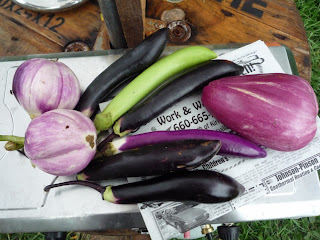You can mark the change of season here by the types of blooming flowers on the land. Right now Ironweed, with its purple flower clusters is everywhere, along with white-flowered false boneset. Soon goldenrod will be the dominant flower, meaning winter is not far off. It and purple aster are the last to bloom here. Below is also a Whorled Milkweed.


Work has continued on the house, though slower than hoped. It seems there are always many delays here preventing us from making progress. The recent monsoons have made some things difficult lately. August is usually unbearably hot and dry, but the only unbearable weather came in June. Last week we got 5 inches of rain in a 12 hour period.
We put up the second floor joists a few weeks ago. We are doing 2x6s between the oak beams and orienting them north-south over the cantilever so the joists will be holding some of the weight of the second floor south wall that will hang out about a foot and a half beyond the first floor south wall.

You can see the 6x6 knee braces on the bottom of the two middle beams that will help transfer some of the weight of the cantilever onto the wall. There will be four of these eventually.


After putting up the joists we put on a subfloor of reclaimed OSB and plywood.


Next, we put on the north wall second floor posts and a girt to connect them.

We added the other two knee braces on the cantilever.

This is the view of the garden and backyard from our second floor. It will be a great view to see every morning.

Then we started on the second floor south wall. It will be a stick framed wall like on the first floor. I think the house looks best from the south. The other villagers won't see the best side, but we will from the backyard.


With the floor on the second floor blocking the sunlight we were able to see how the cantilever will block the high summer sun. Even at this time of year, there is no sun coming in the south side windows. Of course, that's good because we want shade in August and for most of September.
We also walled in the future root cellar, which we'll be able to access through our kitchen floor. We are now continuing with the rafters and roof. The house is really starting to take shape.
The wet season has been good for the garden overall, but after last week's rain, my carrots were rotting in the ground. Most plants have benefited from the rain. I planted eggplant and peppers in the bed that had the chicken tractor over it early in the season and they are the best eggplant I've ever grown. I love eggplant, and we've got plenty of it now.


We started pickling some veggies. My hot pickle mix of hot peppers, carrots, and cucumbers is one of my favorites.


I think I've finally mastered the art of growing beets. This year I planted a few successions and hope to have a bunch to store in the root barrel over the winter. These we turned into pickled beets, following the recipe of Alline, a DR member who with her husband has just opened up the
Milkweed Mercantile and B&B here at the village.

Since I don't have much space in the garden, but I like sweet corn, I planted just two rows of it. Normally you would want to plant a larger plot of it so the ears get well pollinated, but instead I just hand pollinate the ears. It works really well if you have limited space and a small number of plants. We probably got about four dozen ears off my small bed.

The rain was really good for the garlic. We got a really big harvest this season and the heads are hanging up in our house.

Things are looking good at Wisteria Lodge this year too. The wisteria vine is way past the top of the arbor and has sprouted many new shoots now that it's reached the top. I think it will have taken over the whole thing by next summer.





